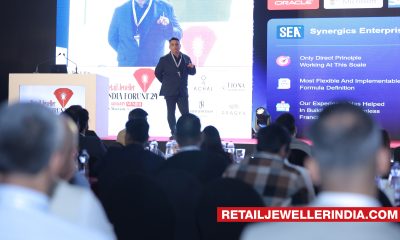Forum 2023
Smart ways in which jewellers can aid consumers’ product search, with AI

Creating a robust jewellery design has always remained challenging for every jewellery retail brand. And, it may take less than a minute for a customer to decide whether the product on display, conceived after months of strategy and research, works. Besides great products, therefore, it becomes necessary for a retailer to dedicate time and research for why conversions succeed.
What if artificial intelligence can enable a retailer to offer designs based on a customer’s preference, then and there?
Talking at the recently concluded Retail Jeweller India Forum 2023, Vivek Das and Sanjib Chatterjee, Founders of Synergics and Trouve (Unlearn Innovation), made a powerful joint presentation on futuristic technology solutions to empower retail jewellers to take the next leap in a digitized world.
Das, who has rich experience in the industry through Synergics Solutions – the company that provides ERP to many top-notch jewellery brands, including CaratLane – guided the audience on how Trouve, a software powered by AI, is providing retailers with intelligent ways to aid their consumer’s product search and helping them analyse customer engagements.
“It is an AI-driven image search technology which can be integrated with legacy software, mobile applications and custom-made e-commerce-enabled web applications to help engage better with your existing customers and grab a bigger wallet share. This tool can allow you to visually control the inventory search and offer design-relevant merchandise to potential customers,” he said. Das shared a couple of classic case studies from other sectors wherein AI has helped brands immensely.
Das demonstrated product detection and visual search through celebrity images. “Through Trouve, one can do not only a visual search based on products but also products worn by celebrities. AI can also show a customer something relevant based on their buying history,” he said.

He then discussed how retailers could use the same tool to purchase more efficient designs from vendors. It finds out the saleability of products through visual analytics. When vendors share new designs, an AI-empowered retailer can compare multiple designs based on their shapes and understand if such designs made the brand any profits earlier or not. “About 90% of information is passed to the brain as visuals, according to MIT, and it takes 13 milliseconds for the brain to identify the visuals. In a survey in the UK, 45% of retailers use visual search. It is time to change and evolve,” he said.
Das cited examples of brands such as Tommy Hilfiger and home-grown brand Shoppers Stop, engaging the customer through shopping anywhere, devising hyper-local retail to blur the line between online and physical and introducing digital touch-points across all showrooms.
“This is how today’s generation shops. I like something, I click a photograph of it and go to my retailer asking for it,” he said. “At that point, technology should enable the customer to locate that particular or similar-looking design from many choices.” Most of these brands have increased their sales because of this visual search technology transformation.
In other industries, the customer’s journey is practically frictionless. He introduced Trouve as a futuristic solution that addresses and resolves the gap in the jewellery industry. Das further emphasized, “In retail, be it a physical or digital journey, it has to be unbroken, converging into a seamless phygital journey.” He cited many international brands, such as Kay in the USA and Signet, that have implemented visual search and used technology to trace customer journeys leading to increased sales.
Das explained how retail jewellers are losing out on building excellent customer experience and business, as there are as many as 16 customer touch-points presently disconnected in retail. “Without integrated retailing, which connects these touch-points as a whole, one would never have accurate visibility into how the customer functions across touch-points.”
Asking why a customer with high spending capacity buys products with lower value, Das said it’s high time for retailers to connect the broken dots of the customer journey. AI-driven engines that trace and track customer journeys are crucial to understanding the nature of conversion or drop-off.
“With Trouve, a customer’s journey gets connected, leading to increased market-share and wallet share, which leads to huge conversions,” he said.
Trouve helps retailers connect all the dots and work on all data about the customer in a singular dashboard, thus bringing in a fantastic powering tool to grow the business, Das concluded.
Talking further about the future possibilities in AI, Chatterjee said, “Providing customers with design options that match their imagination is at the heart of this technology. The power of AI can be curated to present unique designs in a minute. Imagine a customer searching for a mogra concept in earrings, and AI can instantly create unique exclusive designs for prospective customers. This can open immense possibilities and richer customer engagement and personalization, ensuring retailers never lose an opportunity.”

Talking about the SaaS model, Chatterjee pointed out the industry recognition of Trouve from the likes of AWS, Economic Times, and Your Story, besides doing test runs with brands such as Hazoorilal, Manubhai and others to embark on a successful global phygital journey.
Unlearn Innovation operates in seven countries apart from India, empowering customers to decide and purchase faster.
Courtesy: Retail Jeweller India





 Daily News1 month ago
Daily News1 month agoBhima Jewels appoints Ram Charan as brand ambassador, aims to strengthen customer base in India and UAE

 Daily News7 days ago
Daily News7 days agoZoya raises a toast to its muse with designer Gauri Khan via vibrant gala

 Prime Story2 weeks ago
Prime Story2 weeks agoC Krishniah Chetty Group organizes 10-day Ladakh educational expedition for underprivileged students

 Daily News3 weeks ago
Daily News3 weeks agoKavitha Gold & Diamonds appoints actor Fahadh Faasil as brand ambassador, plans major expansion






















